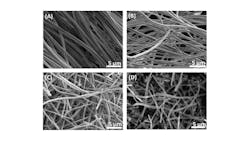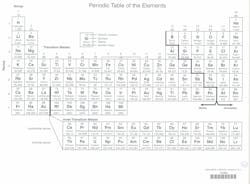Harmful Greenhouse Gases Repurposed into Carbon Nanofibers
After presenting their methods for producing carbon nanofibers to the American Chemical Society this past August, George Washington University (GWU) professors set a conference in Boston abuzz with excitement, and, quite likely, reasonable doubt. Here’s why:
A simple and economic method to synthesize carbon nanofibers (CNFs) has eluded scientists for decades, not to mention one that can repurpose carbon dioxide directly from the atmosphere. According to the report published in NanoLetters, GWU’s “one-pot” synthesis successfully produces high yield CNFs with great structural integrity at lower costs than other methods. In addition, it doesn’t require a separate process to concentrate the atmospheric CO2.
Using Electrolysis to Drive a Reaction
On its own, the combustion reaction where solid carbon is burned in the presence of oxygen gas to form CO2 is irreversible. Combustion engines rely on the energy released from this reaction to produce work.
C solid + O2 (gas) → CO2
The reverse reaction—splitting CO2 back into its original components—requires an external energy source and other intermediate reactions to occur. The GWU team was able to use electrolysis of a molten salt to deposit oxygen at the anode and solid carbon at the cathode in the form of nanofibers.
The basis of electrolysis (see a video here) is simple. Two electrodes are submerged into an electrolyte, which contains free ions suspended in a solution. The ions are drawn to either electrode, depending on their charge. The GWU project used a molten electrolyte, where a salt under high heat changes from a solid into a viscous electrolyte.
Methods and Simple Equations
First the scientists needed a way to trap CO2 from the atmosphere into the system. Knowing that lithium oxide (Li2O) mixed with molten lithium carbonate (Li2O3) rapidly absorbs CO2, they dissolved Li2O in the molten Li2O3 at 6 moles per kilogram and bubbled CO2 from the atmosphere into the mixture.
The process forms a dynamic mixture in equilibrium (below), where reverse reactions occur simultaneously with no net change in the initial concentrations. Therefore, while some Li2CO3 may split into separate CO2 and Li2O molecules, CO2 and Li2O are simultaneously recombining to keep all concentration levels constant.
CO2 (atmospheric or stack) + Li2O (dissolved) ⇌ Li2CO3 (molten), (1)
Splitting Lithium Carbonate
After capturing CO2 in their system, the scientists proceeded to form solid carbon at the cathode by electrolysis of the molten lithium carbonate. First, the system needed to be heated to just below 800˚C; at higher temperatures, carbon monoxide (CO) would accumulate at the cathode instead of solid carbon. Second, they required a current that would supply four moles of electrons per mole of carbon in order to produce tetravalent carbon at the cathode (carbon’s standard “four electrons in the outer shell”). The reaction driven by controlled electrolysis is shown in Equation 2:
Li2CO3 (molten) → C (solid) + O2 (gas) + Li2O (dissolved) (2)
The molten Li2CO3 electrolyte is made up of carbonate anions (CO3-2) and Li+ cations. At the right temperature and voltage conditions, the CO3-2 anion will gain electrons at the cathode to become solid carbon and oxide (O2-) ions. Two of these oxides will then combine at the anode (more positive electrode) via oxidation to produce oxygen gas. (This occurs in an oxide to carbon ratio of 2:1.) Finally, two Li+ cations combine with the leftover oxide ions.
To find a conclusive net equation, the scientists crossed out any of the reagents in equilibrium Equation 1 if they occur on either side of Equation 2. Notice that CO2 does not cancel out of the net equation because it is entering the system from a continuous source:
CO2 (atmospheric or stack) + Li2O (dissolved) ⇌ Li2CO3 (molten) (3)
Li2CO3 (molten) →C solid + O2 (gas) + Li2O (dissolved) (4)
They eventually came up with the net equation that concludes it all:
CO2 (atmospheric or stack) → C solid + O2 (gas) (5)
GWU scientists generated solid carbon via electrolysis of a molten electrolyte by sourcing CO2 from the atmosphere. Success? Not quite.
Getting the Right Structure
The solid carbon that was deposited at the cathode still didn’t have the uniform and straight structure desired by GWU’s scientists. So they experimented with different cathodes, temperatures, additives, and currents until they finally got it right.
Using a zinc-coated (galvanized) steel cathode and an initial low current density, they also added nickel, cobalt, copper, or iron to the electrolyte. These additives joined carbon at the cathode and bonded to it create nucleation sites, or highly reactive locations on carbon chains that force incoming atoms to bond at the sites that generate a stacked structure. Temperatures, extra materials used, and voltage can all be carefully altered to fine-tune the structure of the carbon nanofibers.
You can see the different outcomes of different methods in the figure below.
The last revelation that really got the Chemical Society jumping out of their seats is the impressive range of applications that can be achieved using similar electrolysis chambers and the power of the sun. Project leader Stuart Licht presents the Solar Thermal Electrochemical Process (STEP), which can be explored in the link and supporting article.
About the Author
Leah Scully
Associate Content Producer
Leah Scully is a graduate of The College of New Jersey. She has a BS degree in Biomedical Engineering with a mechanical specialization. Leah is responsible for Machine Design’s news items that cover industry trends, research, and applied science and engineering, along with product galleries. Visit her on Facebook, or view her profile on LinkedIn.




